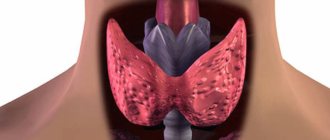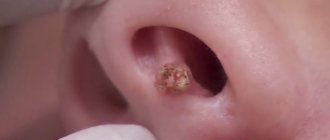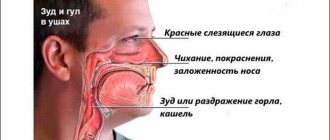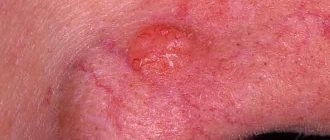What are the main reasons why nasal breathing is difficult? What prevents us from breathing freely through our nose?
Anna Butsel, head of the Department of Ear, Nose and Throat Diseases, BSMU, Candidate of Medical Sciences, Associate Professor: If we talk about seasonal runny noses, then most often these are acute runny noses, acute rhinitis, which develop seasonally against the background of ARVI. Acute runny nose is the most common cause, however, unfortunately, there are other causes: chronic rhinitis, which can be caused by a deviated nasal septum. A severely deviated nasal septum itself can also lead to difficulty breathing through the nose. Difficulty breathing with an acute runny nose manifests itself against the background of swelling of the nasal mucosa, profuse rhinorrhea, that is, discharge from the nasal cavity - all this narrows the lumen of the nasal passages and leads to difficulty breathing through the nose. A runny nose, like any other inflammatory disease, occurs in stages. The first stage is the stage of irritation, when the nasal cavity is dry, itchy, and sneezing.
and the stage does not require vasoconstrictor drops at all. Vasoconstrictor drops are required about a day after the onset of the disease, when the stage of edema begins, when the nasal passages, due to swelling of the mucous membrane, sharply narrow. Copious rhinoria. This stage lasts no more than 3-4 days, so the vasoconstrictor drops required at this time can only be instilled for 3-4 days. Then comes another stage - the stage of mucopurulent discharge. There, vasoconstrictor drops are not needed, and if needed, they are limited. Other antibacterial agents are needed there. Acute runny nose can lead to sinus infections, known as sinusitis. Sinusitis, among which more often ethmoiditis is inflammation of the cells of the ethmoidal labyrinth, sinusitis and frontal sinusitis.
Symptoms of sinusitis and sinusitis
How do sinusitis and sinusitis manifest? What sensations does a person who has developed these conditions experience?
Anna Butzel: First of all, it must be said that sinusitis develops when the inflammatory process is not limited only to the mucous membrane of the nasal cavity, but spreads through natural channels into the air sinuses, which are located around the nasal cavity. In these diseases, the main symptom is headache, and the headache is quite local - the forehead, orbit, sometimes in the area of the sinus itself there is pain and a very characteristic mucopurulent discharge that appears from the nasal cavity.
Most often, this is a one-sided process, which differs from an acute runny nose in the 3rd stage of inflammation. Unilateral process in accordance with the side of the sinus lesion. The danger of sinusitis is dictated, first of all, by the anatomy of the sinus itself. The fact is that the paranasal sinuses, first of all, surround the orbit on all sides and against the background of sinusitis, orbital complications may occur, manifested by swelling of the eyelids, swelling of the eye tissue, which leads to blurred vision. Close contact with the cranial cavity leads to severe complications: rhinogenic, intracranial complications, which, unfortunately, are not so rare today.
Treatment of a runny nose
Irina Dolina, Associate Professor of the Department of Ear, Throat, Nose Diseases of the Belarusian State Medical University, Candidate of Medical Sciences: People say: If you don’t treat a runny nose, it will go away in 7 days, if you treat it, it will also go away in 7 days. This is, of course, a fallacy. A person does not always know the structure of the nasal cavity and the anatomical features that exist in the nasal cavity; they can predispose to a long-term runny nose. Complications of acute rhinitis are acute sinusitis and acute otitis media. If a runny nose is not treated, then such complications will most likely arise in the patient. After visiting a doctor, the patient is given a diagnosis, because many diseases can occur with exactly the same symptoms: nasal congestion, nasal discharge, which can occur with both acute rhinitis and sinusitis. And only a doctor can make a diagnosis.
Anna Butsel: Improper treatment of runny noses leads to the development of chronic runny noses, which are much more difficult to treat. Unfortunately, if patients self-medicate and treat a runny nose on their own, treatment comes down mainly to purchasing vasoconstrictor drugs and instilling these drops throughout the illness, which leads to prolonged treatment of acute runny nose and the development of dependence on vasoconstrictor drops. At the stage of mucopurulent discharge, vasoconstrictor drops are not needed, and if needed, they are limited. Other antibacterial agents are needed there. This treatment leads to a runny nose that will last about 7 days.
Are there any other rare pathologies that otolaryngologists encounter that are quite serious in themselves and impair nasal breathing?
Anna Butzel: Such a rare pathology of the nasal cavity, leading to difficulty breathing through the nose, are, of course, tumors - benign tumors, unfortunately, malignant tumors of the nasal cavity are also diagnosed. In all these cases, observation by an otolaryngologist must be carried out; it is he who determines the need for surgical intervention.
Deformation of the nasal septum. How significantly does it affect nasal breathing?
Anna Butzel: As a practicing doctor, I want to say that we see a perfectly straight nasal septum in very few patients. Due to the fact that the nasal septum has cartilaginous and bone parts, during the growth process the cartilage and bone grow unevenly. In the area where the bony part of the septum and the cartilaginous part come into contact, so to speak, in the growth zone, various forms of curvature can form. This growth process continues until the age of 16. A person can have a curvature in this place and live peacefully, without any complications or diseases from the nasal cavity. The problem is if the curvature of the nasal septum is significant, and even more so if the patient has suffered a nose injury. As a result of the injury, he has a deviated nasal septum, which may result in difficulty breathing through the nose.
Diagnosis of nasal breathing problems
Irina Dolina: The patient has a problem with nasal breathing, so in order to establish the cause of snoring, we begin our examination with an examination of the nasal cavity. An anterior rhinoscopy is performed. We see: in the posterior sections, a curvature of the nasal septum on the right and, as a reaction from the mucous membrane, swelling of the mucous membrane of the nasal cavity, in particular, the inferior turbinates. This is one of the reasons for the patient's snoring.
Anna Butzel: If the nasal septum is curved and there is no difficulty breathing through the nose, then breathe and live calmly. But if, against the background of a deviated nasal septum, chronic runny nose has developed, or the deviated nasal septum itself leads to difficulty breathing, then, of course, surgical treatment is necessary. In this situation, you need to contact an otolaryngologist and he will determine what operation should be performed on this patient.
Anna Butzel: Today there are innovative methods of surgical treatment, which include laser surgery - all this is performed under the control of endoscopic equipment. All this, of course, facilitates the work of the surgeon and the course of the operation itself.
What are adenoids?
Anna Butzel: Adenoids are a physiological condition, most often of a child’s body. This is the so-called pharyngeal tonsil, which in a child grows and develops in the nasopharynx area, that is, in the very posterior parts of the nasal cavity. All children have adenoids, it’s the degree of their severity, how large they are in size, and the state of breathing through the child’s nose depends on this.
Irina Dolina: Complications from adenoiditis in the form of tubar otitis, exudative otitis, purulent otitis are possible. The main complaint is a long-lasting runny nose and prolonged purulent discharge. Very often, parents of small children pay attention to a prolonged cough, which also accompanies adenoiditis.
Anna Butzel: Complications are dictated by the condition of the child himself. First of all, of course, this is immunity, the child does not already have a developed immune system, and parents sometimes take very intrusive care of their children, that is, protect them from the breeze, which leads to the fact that the child often begins to catch colds and get sick. And in any episode of the disease, lymphoid tissue is involved, including the adenoids in this child. Naturally, against this background, they begin to increase in size.
Can an adult still have enlarged tonsils?
Anna Butzel: Unfortunately, they can, and somewhere in 15% of the adult population have these adenoids. They completely lose their physiological significance and are completely useless in an adult; they do not perform a protective function, as they do in a child. They provoke the development of complications - chronic runny nose develops against the background of adenoids, and sinusitis develops. Therefore, we definitely remove adenoids in adults if patients contact us.
Prevention of diseases associated with nasal breathing
Recommendations for preventing the development of the diseases and conditions you mentioned?
Anna Butsel: If we talk about acute runny nose, then naturally, the main method of prevention is hardening procedures, a healthy lifestyle, first of all, because tobacco smoke irritates the mucous membrane of the nasal cavity and pharynx, which predisposes to frequent acute rhinitis of a cold nature. If we talk about chronic rhinitis, then this is, first of all, timely and correct treatment of acute rhinitis. Avoid self-medication; you should definitely consult a doctor, not even necessarily an otolaryngologist. A pediatrician and therapist will help you by prescribing the correct treatment. If we talk about the nasal septum, then first of all you need to always rely and listen to the doctor who examines you and diagnoses a deviated nasal septum, and if the doctor said that correction is required, then surgical treatment is necessary, you must listen to the doctor’s advice and have surgery in a timely manner, contact surgeons.
Source: www.ctv.by
Why does mucus accumulate in the throat?
The sensation of a lump in the throat may appear due to exposure to local irritating factors or general pathological conditions. An accumulation of snot on the back of a child’s throat may be normal. In infants, mucus flows into the throat due to the physiological characteristics of the structure of the nasal passages (narrow lumen) and the inability to blow the nose or expectorate it.
Mucus often flows into the throat from the nasal cavity
The main reasons for the accumulation of mucus on the back wall of the throat in adults and children over one year old include:
Irritation of the mucous membrane of the nasopharynx and oropharynx by polluted air, smoking, spicy hot foods, alcoholic drinks, local medications (sprays, lozenges). When exposed to these factors, the mucous membrane is “protected” by increased production of mucus and its accumulation at the site of irritation. The sensation of a lump between the nose and throat continues until the irritating factor is eliminated. Respiratory tract diseases - chronic bronchitis, sore throat, pneumonia, rhinitis. In this case, the secretion may be released in the form of green snot or clots if the process has a bacterial etiology. In chronic rhinitis, snot accumulates in the throat constantly. Inflammation of the sinuses (sinusitis, sinusitis, ethmoiditis, sinusitis). The inflammatory process is characterized by increased mucus production and impaired elimination, which provokes the accumulation of thick snot between the nose and throat. Diseases of the digestive tract. Stagnation of mucus in the throat is more typical for problems with the esophagus. Allergy. Most often, snot accumulates in the throat due to local exposure to an allergen (dust, fur, pollen) inhaled in the air. Drug-induced rhinitis. It is caused by long-term use of vasoconstrictor nasal drops, which lead to hypertrophy of the nasal mucosa. In this condition, snot is practically not coughed up, and nasal breathing is difficult. Hormonal changes. Overproduction and accumulation of mucus can occur against the background of endocrine diseases, during hormonal changes in adolescence and pregnancy. Neoplasms of the nasopharynx (polyps, tumors), deviated nasal septum. The patient is tormented by constant snot, which makes it difficult or completely blocks nasal breathing.
Chronic sinusitis often causes mucus to accumulate in the nasopharynx
Cyst
Another type of formation in the nose that makes breathing difficult is a cyst. As a rule, cysts form in the nasal cavity, less often in the sinuses. The reason is hypoventilation. The body requires oxygen, and for the nasal cavity it is absolutely necessary. With cysts, unlike polyps, it is somewhat simpler, because they do not have a tendency to become malignant. Finding them is not so easy. For example, they can be determined by chance in flight. When the plane accelerates, the pressure increases, including in the nose, and some kind of amber sticky liquid begins to flow from the nose by itself. This means that there was a cyst in the sinus, its cavity burst.
Cysts can also be a diagnostic finding. They are detected, for example, during an X-ray. A cyst differs from a polyp in that it has a spherical shape. The polyp often has a lumpy or elongated shape.
What are the consequences?
Despite the fact that cysts are more harmless than polyps, there is still no need to grow them in the sinuses. When the cyst presses on the mucous membrane, severe pain develops, and the head begins to ache where the cyst grows. If such a tumor has already appeared, doctors recommend surgery. And if it occupies half of the sinus, then the indication for surgical removal is already 100%.
Signs of mucus accumulation in the nasopharynx
The following signs indicate a violation of mucus transport:
feeling of a lump in the throat; sore or burning throat; discomfort in the throat area; constant desire to cough; difficulty swallowing.
Clots of snot cause a lot of inconvenience, in particular:
interfere with normal breathing; interfere with food intake; cause bad breath or a specific taste.
If mucus stagnation is caused by non-infectious factors, but by local mechanical or chemical irritants, the accumulated mucus is transparent, expectorated, and has a thin consistency. The general condition of the patient does not change.
You can suspect the infectious origin of snot in the throat by the following signs:
violation of the general condition (fever, weakness, chills, malaise); change in consistency and smell of secreted secretions.
What to do if mucus accumulates in the throat?
If you have the above symptoms, you should consult an otolaryngologist. After the examination, the doctor may prescribe additional examinations, consultations, or immediately prescribe treatment.
Possible consultations:
allergist-immunologist, gastroenterologist, infectious disease specialist.
Additional examinations:
general blood analysis; blood test for antibodies to viruses; bacterial culture and microscopy of a nasopharyngeal smear; allergy tests; rhinoscopy; endoscopy of the nasopharynx.
The first person to visit if you have symptoms of mucus accumulation in the throat is an ENT doctor
Additional diagnostics
The cause of discomfort in the nose and difficulty breathing can only be determined through a comprehensive examination. And it includes not only an analysis of clinical symptoms, but also taking into account the results of additional diagnostics. The range of required research includes:
- Analysis of nasal discharge (cytology, culture).
- Rhinoscopy (anterior and posterior).
- Pharyngoscopy.
- X-ray of the sinuses and facial skull.
- CT scan.
The severity of the concomitant inflammatory process can be judged not only by local signs, but also by the indicators of a general blood test. And in persons with a predisposition to hypersensitivity, it is necessary to perform skin tests with allergens. Based on the information received, a conclusion is drawn about the causes of the pathological process and the methods necessary to eliminate it.
How to cure mucus congestion in the throat
The treatment strategy depends on the cause of mucus stagnation in the nasopharynx. To get rid of this unpleasant phenomenon, it is necessary to adhere to an integrated approach. First of all, patients are shown etiotropic treatment aimed at eliminating the cause of the disease.
Etiotropic therapy medications include:
Antibacterial agents. Used to treat snot of bacterial origin. Systemic drugs – Co-trimoxazole, Flemoxin Solutab, Amoxiclav; local action - nasal drops Protargol, Collargol. Antiviral drugs. Used for the treatment of snot that occurs against the background of ARVI or after it: Anaferon, Immunal, Resistol. Anti-inflammatory drugs and antiseptics: Orasept spray, Lugol spray, Ingalipt aerosol. Antihistamines. Used for allergic diseases: Suprastin, Fenistil, Eden, Loratadine.
Drug treatment depends entirely on the cause of the discomfort.
Simultaneously with the main treatment, symptomatic treatment is carried out aimed at eliminating the signs of the disease. You can remove a lump in your throat by rinsing. The procedure allows you not only to liquefy and remove snot that is stuck in the throat, but also to dry out the mucous membrane
To prepare the solution you can use:
soda, potassium permanganate, sea salt, furatsilin, chamomile or sage decoction.
How to rinse correctly: step-by-step instructions
Take a syringe without a needle or a syringe and fill it with rinsing solution. Insert the tip into one nostril. Lean over the sink. Inject the contents of the syringe into the nostril under pressure. If done correctly, the solution will wash through the nasopharynx and exit from the other nostril. Repeat the manipulation 2-3 times.
Instructions for rinsing the nasal cavity
To rinse the nose, you can use ready-made saline solutions (Humer, Aquamaris), which are available in the form of a spray.
Folk recipes
Drink plenty of fluids. 8 glasses of water per day is enough fluid to remove toxins from the body and thin phlegm. Inhalations with eucalyptus oil will help get rid of snot that collects in the throat. Drink a paste of crushed aloe leaves with honey in the morning and evening. A mixture of dried calendula flowers with honey inside.
The accumulation of secretions in the nasopharynx in most cases indicates various diseases or allergies. If you feel discomfort or a lump in your throat, you should consult a doctor. Due to the polyetiology of the symptom, self-medication may be ineffective.
Otolaryngologists hear complaints about mucus scraping in the throat quite often. Moreover, this feeling is not always accompanied by a cold. The same can be said about the feeling of a tickle or lump in the throat, which is accompanied by constant coughing. A similar mucus is felt approximately in the area of the Adam's apple.
Many doctors believe that this phenomenon is associated with laryngopharyngeal reflux, in which gastric contents can back up into the throat from time to time. In this case, heartburn will be felt if the contents are sour, but if the contents are not acidic, there will be no heartburn, although irritation by the aggressive liquid for the throat will still occur. This initiates the formation of mucus in the throat, coughing and spasm of the muscles that control the expansion and contraction of the pharynx. And this already manifests itself in the feeling of a lump in the throat.
To make a diagnosis, the larynx, pharynx, esophagus and stomach are examined using an endoscope. An X-ray examination of the esophagus and a daily check of the acidity of the contents of the esophagus are also possible. Here, long-term courses of medications called proton pump inhibitors are most often prescribed for treatment. These include Omeprazole.
However, if the disease is not advanced, lifestyle changes may be sufficient to help reduce the likelihood of relapse.
Causes of mucus accumulation between the nose and throat
These include refusing to eat before bed, in addition, you should try to raise the head of the bed, increase the size of the pillow or use a special mattress, give up alcohol and coffee, and also try not to eat fatty, fried and spicy foods.
However, severe cases of this pathology require surgical treatment.
Another reason for the feeling of mucus accumulation in the throat may be postnasal drip, in which mucus from the nasal cavity (snot) flows down the back wall of the throat, which, by the way, you can determine for yourself by shining a light on your throat and looking in the mirror. This phenomenon, to some extent, is a variant of the norm, in which a certain amount of mucus can flow from the nose into the throat. However, with postnasal drip, there is excess mucus draining into the throat. Here, treatment consists of overcoming a specific disease of the nose or paranasal sinuses, since such excessive drainage occurs in allergic or vasomotor rhinitis, sinusitis and a number of other ENT diseases.
In some cases, the feeling of mucus in the throat can be caused by food intolerance, mainly dairy products, of a non-allergic nature.
There are a number of diseases in which saliva production decreases, for example, Sjögren's syndrome, and a thick clot of phlegm also forms in the throat. A similar phenomenon is observed with mouth breathing and dehydration.
Quite rarely, a similar phenomenon can develop with Zenker’s diverticulum, which is one of the diseases of the esophagus. This is where something like a pocket appears in the esophagus in which food can be retained.
In other words, the feeling of mucus between the throat and nose can be a symptom of a wide variety of diseases, however, in the vast majority of cases it cannot be life-threatening.
The most interesting news
This is an entry in the Beauty and Health category
The accumulation of mucus in the human nasopharynx can occur for various reasons. Most often, this may indicate the presence of a respiratory disease, problems with the gastrointestinal tract, or the development of an allergic reaction.
To correctly determine the causes, it is necessary to undergo an extensive medical examination. Only after this will a qualified specialist be able to establish an accurate diagnosis and prescribe effective drug treatment.
For timely detection of the disease, it is important to know what symptoms may appear.
Crooked septum
One of the most common malfunctions of the nose is a deviated septum. It’s difficult to call it a formation, but at the same time it can stick out so much that it becomes like him. There are situations when a person thinks that something has grown in his nose, and this is just a curvature.
There are many options for exactly how a septum can be bent: from simple, accompanied by an asymptomatic course, to complex. It often happens that curvature is a consequence of a hereditary factor. According to the type of curvature, each case is different from the others. There are options with a curvature by an arc - like a rocker - in one or the other side of the nasal cavity, there is a violation only in the cartilaginous or bone part, and sometimes in both at the same time. Sometimes the septum is curved like the letter S of the English alphabet; there are situations when it actually represents a wave protruding in a certain area, and it can also have a spike that will resemble a needle.
Also, deviated septum can be acquired after any injury. For example, a child can easily get hit on the nose in kindergarten, and parents won’t even know about it; teenagers get injured in sports clubs and on the streets. In adults, the problem can arise from injuries at construction sites, in fights, etc.
How does mucus accumulate in the throat?
Very often, a person may feel a lump in the throat. Its occurrence is associated with the action of certain irritants or pathological conditions of the body. For example, for children, the accumulation of a small amount of snot in the throat is considered acceptable. For infants, the appearance of mucus is associated with the physiological structure of the respiratory organs (thin lumens), as well as with the inability to spit out accumulated mucus in time.
Quite often, adults who do not monitor their health also face a similar problem.
Usually mucus enters the throat through the nasal passages. You must be very careful when the first symptoms of the disease appear!
Causes of mucus accumulation in the nasopharynx
Today, doctors identify the following reasons that can affect the accumulation of sputum in the nasopharynx:
The influence of external stimuli on the nasopharynx. This primarily includes hot food, drinking alcohol, and taking medications (spray, lozenges). In order to protect itself, the mucous membrane begins to actively secrete mucus. An unpleasant feeling of a lump in the throat can haunt a person until the irritant itself is eliminated. Presence of respiratory diseases. Very often, such sensations can occur during bronchitis, rhinitis, tonsillitis and pneumonia. During these diseases, sputum may form in the form of green snot or small clots (if bacteria are present). If rhinitis is chronic, then mucus in the throat will accumulate daily. Inflammatory process in the nasal sinuses. Inflammation is most often observed with
Mucus in the nasopharynx can cause a lot of discomfort
the presence of sinusitis, frontal sinusitis, ethmoiditis and sinusitis. Due to severe inflammation, mucus is released at a very high speed. The body is unable to eliminate it on its own. For this reason, it can accumulate in large quantities between the nose and throat.
Disease of the digestive system. There are cases when stomach problems became the main reason for the formation of mucus in the throat. To eliminate it, it is necessary to undergo a medical examination and begin prompt treatment. Presence of allergic reactions. The accumulation of mucus can also be caused by an allergy to dust, animal dander or plant pollen. Drug-induced rhinitis. This disease develops as a result of long-term use of a vasoconstrictor drug (nasal drops or spray). Their use greatly deforms and destroys the nasal mucosa. The consequence of this is an accumulation of snot and the inability to cough it up on your own. Restructuring of hormonal levels in the body. The accumulation of mucus can be observed during the course of diseases that are associated with the endocrine system. Teenagers who are going through puberty also often encounter this problem. It is possible that unpleasant symptoms may occur during pregnancy. Presence of neoplasms. Tumors and polyps not only lead to deformation of the nasal septum, but also provoke the appearance of mucus. It, in turn, prevents a person from breathing independently, which causes great discomfort.
The presence of chronic sinusitis in a person may be the first reason that mucus appears in the nasopharynx!
Symptoms of nasal polyps
1. The first sign is nasal congestion and difficulty breathing. This symptom is caused by the fact that the mucous membrane, which has grown significantly, partially or completely blocks the space of the nasal passages.
2. Formation of mucous or mucopurulent discharge, runny nose. In this case, a secondary infection occurs, and the mucous glands work hard.
3. Sneezing, which appears due to the fact that the grown mucous membrane touches the eyelashes, and they perceive it as a foreign body. A simple defensive reaction is developed that would allow one to get rid of it.
4. Sensitivity to odors may disappear or a partial loss of smell may occur. The connective tissue grows in size, and therefore the functioning of the receptors that are able to perceive odors is disrupted.
5. Unpleasant headache. The overgrown tissue of the nerve endings is compressed. Oxygen starvation of the brain begins, as polyps block the passage of oxygen. Inflamed paranasal passages may also be the cause.
6. Voice disorder. The nose plays an important role in the formation of the voice. If the passage of air is disrupted, then the person begins to speak through his nose.
You must be extremely careful with this disease, because any unforeseen complications may arise. As mentioned earlier, nasal polyps interfere with the passage of air through the nose. What's going on? The sick person replaces breathing through the nose through the mouth. As a result, unwanted dry and cold air enters his respiratory tract. New unpleasant symptoms appear, caused by certain diseases.
For example, laryngitis, pharyngitis, bronchitis, pneumonia, tracheitis. It is also possible that communications between the paranasal sinuses and the nasal cavity are blocked, and this threatens the formation of inflammatory processes and the development of sinusitis. If the polyps are large, then there is a risk of compression of the vessels, the blood circulation of the tissues of the nasopharynx is disrupted, and this can lead to inflammation of the pharyngeal tonsil, auditory tube, middle ear, and palatine tonsils.
How can you tell if mucus is accumulating in your throat?
The formation and accumulation of mucus in the nasopharynx may be primarily indicated by the following symptoms:
Constant feeling of a lump in the throat Frequent soreness Unpleasant sensations in the throat throughout the day You always want to cough and clear your throat It becomes very difficult to swallow food
The accumulation of snot in the throat can also become a serious problem, which will present a lot of inconvenience to a person, in the form of:
Heavy breathing Inability to eat food Bad breath
When stagnation of mucus is provoked by the action of a chemical or mechanical irritant, the accumulations will have a transparent color and be runny. At the same time, the person’s well-being will not deteriorate.
If there is an infection, a person will exhibit the following symptoms:
To treat the disease, inhalations are recommended
Deterioration in health (increase in body temperature, weakness, lethargy) Sputum becomes thicker and has a specific odor
As you can see, the symptoms of mucus accumulation can be very diverse. It is very important to notice them in time and seek help from a specialist!
I can not breathe. What to do if you have a deviated nasal septum?
Almost all of us are born with a deviated nasal septum - dislocation occurs during childbirth. So this defect may well be considered normal, and you can live with it for at least a hundred years. Doctors only talk about the presence of a problem if the curvature prevents a person from breathing normally and causes complications. What to do in such cases? Is surgery always necessary? Or can I get by with conservative treatment? We are talking about all this with the head of the otolaryngology department of the Mariinsky Hospital, Andrei SAVINY.
PHOTO by Alexander DROZDOV
– Andrey Nikolaevich, if we compare St. Petersburg and the North-West with other regions of Russia, is the pathology of respiratory failure more common in our country?
- Yes, much more often. The reason is our climate; in Crimea, for example, such pathologies are almost never found. And here we have very humid air, winds, rains, and frequent weather changes. Hence colds, runny nose, asthmatic phenomena and, as a result, difficulty breathing.
Mucus accumulates in the throat, what should I do?
If you notice any of the listed symptoms, you should immediately consult a doctor. After a thorough examination of the patient, he may advise consulting with additional specialists, as well as undergoing some tests:
General blood test Blood for antibodies and viruses Nasopharyngeal swab Tests for allergies Rhinoscopy Endoscopy
It is very important to first seek help from an ENT doctor!
How to get rid of mucus in the nasopharynx?
The specialist prescribes treatment depending on what caused this unpleasant phenomenon.
In order for recovery to proceed faster, it is important to follow all the doctor’s recommendations and monitor your daily routine and diet. To eliminate mucus stagnation, the patient is first prescribed etiotropic treatment. This is necessary in order to cope with the underlying disease.
Etiotropic therapy drugs:
Antibacterial drugs. If snot has caused bacteria to enter the body, then only medications of this type should be used. Co-trimoxazole, Flemoxin Solutab and Amoxiclav have proven themselves well. Among the drops, Protargol and Collargol were effective. Antiviral agents. They are necessary to eliminate snot that appears due to ARVI. For adults and children, you can use Anaferon, Immunal and Resistol. Antiseptics Orasept, Lugol spray and Ingalipt aerosol will help relieve inflammation in the nasopharynx.
Gargling with herbal infusions is one of the ways to get rid of mucus in the nasopharynx
Antihistamines are necessary to eliminate allergies. Experts recommend using Suprastin, Fenistil, Eden or Loratadine.
Self-prescribing medications is strictly prohibited! To choose medications, you need to know the cause of unpleasant symptoms!
To make the healing process faster, it is advisable to use additional nasal rinsing. This will make it possible to get rid of the lump in the throat, as well as dry out the nasal mucosa a little.
Nasal congestion without runny nose: causes and treatment
Many people sometimes experience nasal congestion. This leads to a significant deterioration in overall health and disruption of natural breathing.
Most often, this problem occurs due to rhinitis, which is accompanied by copious discharge. However, sometimes the nose gets stuffy without a runny nose. Difficulty nasal breathing with dryness may indicate the presence of a serious illness.
Therefore, it is necessary to immediately identify the causes of nasal congestion without a runny nose before treatment and cure the stuffy nose.
Why does my nose get stuffy?
There are various causes of nasal congestion without a runny nose, which you should definitely familiarize yourself with. This will help further determine the most appropriate treatment methods.
Vasomotor rhinitis
Quite often, nasal congestion without snot appears due to a vasomotor or incompletely cured runny nose. This problem can manifest itself in different ways. In some patients, at first one nostril cannot breathe, and then heavy discharge appears. However, for others, the nasal cavity may be stuffy and dry. Dryness can last for a week if left untreated.
Over time, pain with sensations of strong pressure in the nasal cavity is added to the symptoms.
Allergies
Sometimes prolonged nasal congestion without a runny nose appears due to allergic reactions. Most patients with allergies produce a lot of thick mucus, but some have a stuffy nose without snot. Most often, such dryness is observed in older people over 40 years of age.
Polyposis
The appearance of nasal congestion without snot is sometimes accompanied by polyposis. This leads to the formation of small benign tumors in the canals. Over time, they increase significantly and because of this, the nose is constantly stuffy and there is no snot. It is necessary to treat polyposis, as it leads to swelling of the mucous membrane.
Rhinopharyngitis
There are cases when a feeling of congestion occurs after the onset of posterior rhinitis. During this disease, thick mucus appears in the nasal canals. However, it does not flow out through the nostrils, but flows down the walls of the larynx. It is because of this that many patients feel that they have absolutely no snot.
Sinusitis
Some people have a constantly stuffy nose due to sinusitis, during which the sinuses become very inflamed. In addition to the feeling of constant nasal congestion without a runny nose, other symptoms may begin to develop:
- pain in the forehead;
- high body temperature;
- feeling of fullness of the mucous membrane.
Sinusitis is also accompanied by swelling, due to which the secretion of purulent mucus is blocked. Therefore, with sinusitis, snot may not flow from the nose.
Dehydration
If your nose is stuffy and there is no runny nose, then you should think about dehydration. After all, an insufficient amount of water impairs the performance of the glands that are responsible for secreting muconasal secretions. Also, due to insufficient fluid, the mucous membrane will begin to become inflamed and swollen.
Most often, fluid deficiency is caused by the following reasons:
- daily inhalation of dusty air;
- regular consumption of carbonated drinks;
- low air humidity;
- impaired drinking regime.
Injuries
Often the cause of difficulty breathing is burns and mechanical injuries to the mucous membrane. Because of this, inflammation of the ciliated epithelium begins to develop. In this case, treatment should be carried out using decongestants or solutions that could restore tissue after burns.
When your nose is stuffy and there is no runny nose, it is recommended to visit a specialist so that he can accurately determine the cause of this problem. Currently, there are several effective diagnostic methods, which include:
- Posterior rhinoscopy. Only adults can undergo such an examination, since it is quite difficult to do posterior rhinoscopy when examining children. This procedure allows the doctor to assess the condition of the ear canals and nasopharynx.
- Anterior rhinoscopy. It is carried out to identify foreign tumors and deviated septum in the nasal cavity. The procedure takes place under the strict supervision of a doctor. The disadvantage of anterior rhinoscopy is the inability to clearly examine the nasopharynx.
- Rhinopneumotherapy. To identify why nasal breathing is very difficult, rhinopneumotherapy is often performed, with which you can evaluate the passage of air through the nostrils. This is done with a device that determines the air pressure in the nose.
- Endoscopy. Chronic nasal congestion without a runny nose is diagnosed using endoscopy. The procedure is performed using an endoscope with a small camera at the end. An endoscope is inserted into the most clogged nasal canals to identify possible tumors in them.
How to treat congestion
It is imperative to treat nasal congestion before the first serious complications appear. There are various ways to get rid of nasal congestion without a runny nose.
Use of medications
Most often, if the nose is stuffy and there is almost no snot, medications are used for treatment.
Rinorin
When it is difficult to breathe through your nose and the snot does not flow, you can use Rhinorin.
This spray is very effective in dehydrating the mucous membrane, as it can be used to restore its moist state and get rid of bacterial or viral infections in the nasal cavity.
During use, Rhinorin is first injected into one nostril. Half an hour later, the drug is injected into the second. The procedure is repeated 2-4 times a day for five days.
Tizin
To make it less difficult to breathe, you can use Tizin. These drops contain tetrahydrozoline hydrochloride, which reduces the size of blood vessels and stops inflammation. Thanks to this, nasal breathing is normalized.
Before using Tizin, it is recommended to thoroughly rinse the nasal cavity with heated water. During instillation, 2-4 drops are dripped into each nostril. We inhale the drops twice a day every day. Periodic use of such medications will allow you to get rid of nasal congestion without discharge in a week.
Galazolin
For nasal congestion and acute rhinitis, some patients use Galazolin. Drops help restore the previous capacity of the nasal passages and significantly reduce their swelling. They also help clear the nasal cavity if it becomes very clogged.
Galazolin can be used to treat adults and children over two years of age. To cure a child under six years old, you need to periodically pour two drops into one of the nostrils. When treating an illness in an adult, the dosage is increased to three drops. It is not recommended to use Galazolin for a very long time. The course of treatment should last no more than two weeks.
Otrivin
When there is no snot and your nose is not breathing, you can use Otrivin, which will help cope with any congestion. This product contains xylometazoline, which improves nasal breathing.
The drug has no contraindications and therefore can be used by anyone.
Otrivin is instilled twice a day, three drops. In the first few minutes after use, there may be slight discomfort in the nasal cavity. The product can be used continuously for no longer than one week.
Clarinase-12
If your nose is difficult to breathe due to severe swelling, you can use Clarinase-12 tablets during treatment. This remedy has an adrenomimetic effect, due to which the swelling of the membrane is removed. Also, such tablets are very effective if congestion is caused by allergies.
Before treating congestion with this drug, you need to decide on the dosage. Clarinase-12 should be taken twice a day before meals, one tablet. The duration of treatment is 10-15 days.
Folk remedies
When medications do not help, then all that remains is to use traditional methods of treatment. Before you start treatment with folk remedies, you need to familiarize yourself with the most effective recipes that will help cure congestion in adults and children.
Boiled eggs
If there is no runny nose, you can restore the condition of the nasal cavity with boiled eggs. To do this at home you need to boil 2-3 chicken eggs. After this, they are applied for 10-20 minutes to the nose near the maxillary sinuses. The procedure is repeated daily for a week. If congestion still remains, you will have to repeat the treatment.
Salt with water
If the runny nose has passed, but there is no congestion, then this indicates swelling of the mucous membrane. Sometimes it can remain even if the nasal cavity is completely cleared of mucus.
You can get rid of swelling using a prepared saline solution. To prepare it, always add a few pinches of salt and two drops of iodine to a liter of water. All this is mixed and buried.
It is worth noting that this remedy treats not only congestion, but also colds.
Ginger root
A clogged nose can be cured with the help of medicines prepared from ginger root. To do this, it is mixed with honey in a ratio of two to one. Then 100 grams of finely chopped lemon is added to the mixture. When the nose is not breathing, the prepared liquid is instilled into the nasal cavity. If the channels continue to become clogged, the procedure is repeated.
Onion
There are also folk remedies for nasal congestion that can be prepared from onions. To do this, one onion is thoroughly peeled and finely chopped into several pieces. Then it is placed in a garlic press to squeeze out the juice. If there is even a little bit of unsqueezed onion left in the garlic press, the juice is squeezed out again.
After this, the resulting liquid is filtered with gauze and diluted with hot water. The prepared mixture is poured into a jar and tightly covered with a lid.










